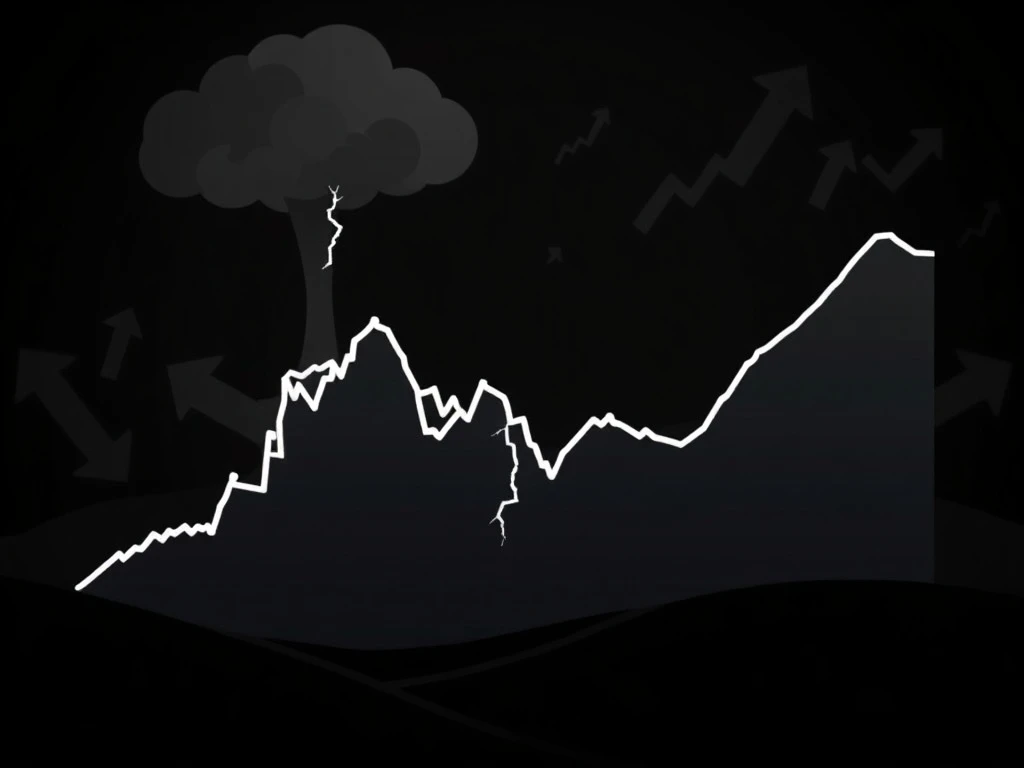The S&P 500 recently soared past 6,400 for the first time. This unprecedented milestone naturally sparks widespread investor enthusiasm. However, a deeper look reveals several compelling reasons for **S&P 500 caution**. Savvy investors understand that record highs do not guarantee future gains. Therefore, vigilance remains paramount in the current market climate. This article explores key factors contributing to this cautious outlook, offering insights for those navigating today’s complex financial landscape.
Understanding the S&P 500’s Ascent and the Need for S&P 500 Caution
The S&P 500’s recent climb reflects robust corporate earnings and optimism surrounding technological advancements. Furthermore, sustained economic growth has provided a strong tailwind. Many companies reported impressive quarterly results. This fueled positive market sentiment. Yet, a closer examination reveals potential vulnerabilities. Investors should exercise **S&P 500 caution** despite these impressive headline figures. Market exuberance often precedes periods of correction. Therefore, understanding underlying dynamics becomes crucial for informed decision-making.
Several factors have propelled the index upwards. For instance, technological innovation continues to drive growth. Large-cap tech stocks, in particular, have shown significant gains. These companies hold substantial market capitalization. Their performance heavily influences the overall index. Consequently, the market concentration has increased. This reliance on a few dominant players can introduce risks. It highlights a specific area for **S&P 500 caution**. A downturn in these key stocks could disproportionately affect the broader market.
Economic Indicators Signaling S&P 500 Caution
Various economic indicators suggest a need for **S&P 500 caution**. Inflation remains a persistent concern. While cooling from its peak, price pressures still affect consumer purchasing power. Central banks, notably the Federal Reserve, continue to monitor inflation closely. Their monetary policy decisions directly impact market liquidity. Higher interest rates, for example, can increase borrowing costs for businesses. This might slow economic expansion.
Moreover, the labor market shows mixed signals. While unemployment rates remain low, some sectors report cooling demand. Wage growth, while beneficial for workers, can contribute to inflationary pressures. Consumer spending patterns also warrant attention. Any significant slowdown could signal broader economic weakness. Historically, such shifts often precede market corrections. Therefore, prudent investors adopt **S&P 500 caution** when interpreting these complex economic data points.
Furthermore, global economic uncertainties add another layer of complexity. Geopolitical tensions, trade disputes, and supply chain disruptions persist. These external factors can impact corporate profitability. They introduce volatility into global markets. Consequently, the interconnectedness of economies means that problems abroad can quickly affect domestic markets. This global landscape certainly necessitates **S&P 500 caution** for investors.
Valuation Concerns and Market Speculation Requiring S&P 500 Caution
Current market valuations present a significant reason for **S&P 500 caution**. Price-to-earnings (P/E) ratios for many S&P 500 companies appear elevated. This indicates that investors are paying a premium for future earnings. High valuations can suggest that the market has already priced in significant growth. Therefore, future upside potential might be limited. A market correction could occur if earnings do not meet these high expectations.
The concentration of market gains also raises flags. A handful of mega-cap technology companies largely drive the S&P 500’s performance. This creates a narrow market breadth. When a few stocks dominate, the index becomes vulnerable. Any negative news or a significant sell-off in these specific companies could trigger a broader market decline. This phenomenon underscores the importance of **S&P 500 caution**. Investors should diversify their portfolios to mitigate such concentration risk.
Furthermore, increased retail investor participation and speculative trading activities contribute to market volatility. Social media trends and rapid information dissemination can amplify market movements. This often leads to irrational exuberance in certain sectors. While this can drive prices higher in the short term, it also increases the risk of sharp pullbacks. Such speculative behavior historically precedes periods of heightened **S&P 500 caution**. It reminds investors to focus on fundamental analysis rather than chasing trends.
Geopolitical Tensions and Their Impact on S&P 500 Caution
Geopolitical tensions represent an undeniable factor contributing to **S&P 500 caution**. Ongoing conflicts in various regions introduce significant uncertainty. These events can disrupt global trade routes. They also impact energy prices. Supply chains, already fragile, face renewed pressure. Such disruptions can directly affect corporate earnings. Companies may experience higher operational costs. This can lead to reduced profitability.
Moreover, political instability in key economic blocs creates ripple effects. International relations influence investment flows. Sanctions or trade barriers can impede global commerce. These actions can dampen economic growth prospects worldwide. Investors, therefore, must consider the broader geopolitical landscape. It plays a crucial role in market stability. This global interconnectedness strongly reinforces the need for **S&P 500 caution**.
The risk of cyberattacks also looms large. Critical infrastructure and financial systems remain targets. A successful, widespread attack could cause significant market disruption. It could erode investor confidence. Consequently, governments and corporations invest heavily in cybersecurity measures. Despite these efforts, the threat persists. This emerging risk factor certainly adds to the overall **S&P 500 caution** among market participants. Monitoring these developments is essential for risk management.
Historical Precedents for S&P 500 Caution
History provides valuable lessons regarding market peaks and subsequent corrections. Periods of extreme market exuberance often precede significant downturns. For instance, the dot-com bubble burst in the early 2000s. The housing market collapse of 2008 also serves as a stark reminder. Both events followed periods of rapid growth and widespread optimism. These historical precedents highlight the importance of **S&P 500 caution**.
Market cycles are a fundamental aspect of investing. They involve phases of expansion, peak, contraction, and trough. Understanding these cycles helps investors prepare for potential shifts. A prolonged bull market, like the current one, can foster complacency. However, corrections are a natural part of the market process. They help to rebalance valuations. Therefore, expecting some degree of volatility is prudent. This historical perspective reinforces the call for **S&P 500 caution**.
Investors often look to indicators like the Shiller P/E ratio (CAPE ratio) for historical context. This cyclically adjusted price-to-earnings ratio can signal overvaluation. When the CAPE ratio is significantly above its historical average, it suggests potential for future lower returns. Currently, this ratio remains elevated. This further supports the argument for increased **S&P 500 caution**. Learning from past market behaviors can inform better investment strategies.
Navigating the Current Landscape: Strategies for Investors Amidst S&P 500 Caution
Given the various reasons for **S&P 500 caution**, investors should adopt strategic approaches. Diversification remains a cornerstone of prudent investing. Spreading investments across different asset classes reduces risk. It also includes diversifying across various sectors and geographies. This strategy helps cushion against downturns in specific market segments. Therefore, do not put all your eggs in one basket.
Maintaining a long-term perspective is equally vital. Short-term market fluctuations can be unsettling. However, focusing on long-term financial goals helps investors avoid emotional decisions. Market corrections are often temporary. Patient investors can weather these storms. This approach aligns with a balanced view of **S&P 500 caution**. It encourages thoughtful planning rather than reactive trading.
Furthermore, regular portfolio rebalancing is crucial. This involves adjusting your asset allocation periodically. It ensures your portfolio aligns with your risk tolerance. Selling some assets that have performed well can lock in gains. Reinvesting in underperforming assets can provide future growth opportunities. This disciplined approach helps manage risk effectively. It actively incorporates **S&P 500 caution** into investment practices.
Staying informed about economic trends and market news is also essential. Knowledge empowers better decision-making. However, avoid acting on every piece of news. Focus on credible sources and fundamental analysis. Consult financial advisors for personalized guidance. Their expertise can help navigate complex market conditions. Ultimately, informed vigilance remains the best defense against market surprises. This proactive stance embodies true **S&P 500 caution**.
The S&P 500’s ascent above 6,400 marks a significant achievement. It reflects strong corporate performance and technological innovation. However, a comprehensive analysis reveals compelling reasons for **S&P 500 caution**. Economic indicators, high valuations, and geopolitical tensions all suggest vigilance. Investors must balance optimism with a realistic assessment of risks. By adopting diversified strategies, maintaining a long-term view, and staying informed, investors can navigate the current market landscape wisely. Prudence remains key to safeguarding investments in these exciting yet uncertain times.
Frequently Asked Questions (FAQs)
1. What does ‘S&P 500 caution’ mean for the average investor?
It means exercising prudence despite market highs. Investors should review their portfolios, understand potential risks, and avoid impulsive decisions. It encourages a balanced and informed approach to investing.
2. Are high P/E ratios always a sign of impending market correction?
Not always, but they indicate that assets are expensive relative to earnings. High P/E ratios suggest that significant future growth is already priced in. This increases the potential for sharper pullbacks if expectations are not met.
3. How can I protect my investments if a market downturn occurs?
Diversification across different asset classes, sectors, and geographies helps. Maintaining a long-term investment horizon and regularly rebalancing your portfolio are also effective strategies. Cash reserves can provide opportunities during downturns.
4. What role do interest rates play in S&P 500 caution?
Higher interest rates can increase borrowing costs for companies and consumers. This can slow economic growth and reduce corporate profits. Consequently, higher rates often lead to lower stock valuations and increased market caution.
5. Should I sell all my S&P 500 investments due to these warnings?
Not necessarily. ‘S&P 500 caution’ encourages risk assessment, not panic selling. Consult a financial advisor to align your investment strategy with your personal financial goals and risk tolerance. Long-term investors often ride out market volatility.
6. What is market breadth, and why is it important for S&P 500 caution?
Market breadth refers to the number of stocks participating in a market move. When only a few large stocks drive the index, it indicates narrow breadth. This suggests underlying weakness and increases vulnerability. It is a key indicator for S&P 500 caution.








